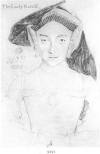Mary RADCLIFFE
Born: 1550Died: 1616/7
Father: Humphrey RADCLIFFE (Sir)
Mother: Isabel HARVEY

|
Mary Radcliffe was the daughter of Sir Humphrey Radcliffe of Elstow andd Isabella Harvey. She was cousin of Thomas Radcliffe, third Earl of Sussex; and of Henry Radcliffe, fourth Earl.
|
During the reign of Henry VIII, Robert Radcliffe, first Earl of Sussex and his son and a party of friends rode out of London to take part in a tournament. In the village of Kensigton, a girl, Isabel Harvey, who with her father, a wealthy London merchant, happened to be visiting some friends, leaned out so far in her eagerness to see the gay cavalcade that she droped her glove. Sir Humphrey dipped his lance, impaled the glove, and returned it to her owner. Isabel beauty had cast such a spell upon Sir Humphrey that he contrived toleave his companions. Edmund Harvey and his daughter were about to set off for London, and as the road thence bore an evil reputation, the merchant readily acquiesced in the knight´s (represented himself as a squire in service with Earl of Sussex) suggestion that he should bear them company, and so agreeable did he make himself that when they reached Harvey´s house in Cheapside he received an invitation to come in to supper. Friendship with Isabel soon ripened into love, nor did her father raise any objection when asked to give his consent to their marriage. Isabel Harvey came to her husband a richly dowered bride, but they have been married some time before she learned the fact that her husband was the son, not the servant, of Robert of Sussex, Lord High Chamberlain of England. The Hans Holbein the Younger drawing at Windsor inscribed “The Lady Ratclif” may be Isabel Harvey, although neither the date of her marriage nor the date of the drawing are known. Other likely candidates (Elizabeth Howard, Lady Fitzwalter; Margaret Stanley, Countess of Sussex; Mary Arundell, Countess of Sussex) would not have been called Lady Radcliffe. |
Lady Radcliffe (possibly Isabel Harvey) By Hans Holbein |
They settled at Edgworth, Lancashire and Elstow, in Bedfordshire, where Mary, their first child, was born. She grew up to be a beautiful accomplished girl.
New Year's Day was the most important day of the year at Court, for on it, according to established custom, the sovereign received gifts from the chief subjects of her realm. The presentations took place in the presencechamber, where Elizabeth in regal finery took her seat on a velvet canopied, jewel-encrusted throne, whilst whiteclad Maids of Honour grouped themselves to form an effective background. In 1561 Sir Humphrey Radcliffe brought forward his daughter Mary and laughingly presented her as a New Year's gift.
Elizabeth, being in high good humour, replied graciously that she would take Mary to be one of her Maids of Honour, for by the death of Lady Jane Seymour, the imprisonment of Lady Catherine Grey and the marriage of Lettice Knollys, there were several vacancies in the privy chamber.
She actually came to court as a maid of honor in 1564 at the age of fourteen. Mary soon became a great favourite with her royal mistress, the more so because it really seemed as if at last she had found a Maid of Honour of like thinking with herself on the subject, of matrimony. From the first Mary refused to take the courtiers at their own valuation, making shrewd estimation of the facile flatterers, who in the Queen's presence professed to be dazzled by her beauty, but directly her back was turned made ardent protestations of love to the Maids of Honour. Thomas Dekker, in "The shoemakers Holiday", said:
"With 'lovely lady,' 'mistress of my heart,'
'Pardon your servant,' and the rhymer play,
Railing on Cupid and his tyrant's dart."
Mary laughed at their flowery phrases, saying straightly to one whose attentions wearied her, "that his wit was like custard, nothing good in it but the sop, and when that was eaten you might throw away the rest".
John Farnham was one of her admirers. Many men wooed Mary Radcliffe, but after a tepid love affair with a gentleman of the temple she settled down to obdurate virginity, serving the Queen as Keeper of the Jewels "honourably, virtuously, and faithfully for forty years", earning a stipend of £40 a year.
Sources:




